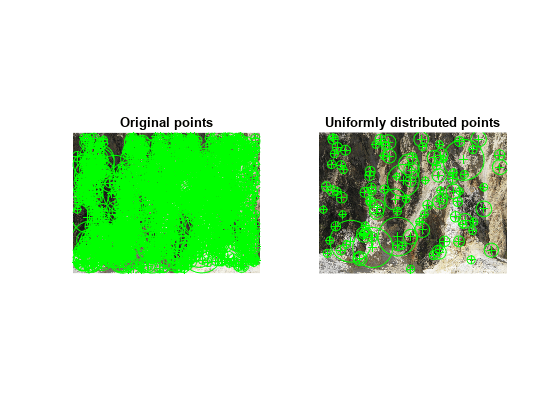selectUniform
Select uniformly distributed subset of point features
Description
Examples
Read an image.
im = imread("yellowstone_left.png");Detect and display KAZE features.
points1 = detectKAZEFeatures(im2gray(im))
points1 =
6713×1 KAZEPoints array with properties:
Location: [6713×2 single]
Metric: [6713×1 single]
Count: 6713
Scale: [6713×1 single]
Orientation: [6713×1 single]
subplot(1,2,1) imshow(im) hold on plot(points1) hold off title("Original Points")
Select a uniformly distributed subset of points.
numPoints = 100; points2 = selectUniform(points1,numPoints,size(im))
points2 =
100×1 KAZEPoints array with properties:
Location: [100×2 single]
Metric: [100×1 single]
Count: 100
Scale: [100×1 single]
Orientation: [100×1 single]
subplot(1,2,2) imshow(im) hold on plot(points2) hold off title("Uniformly Distributed Points")

Load an image.
im = imread("yellowstone_left.png");Detect many corners by reducing the quality threshold.
points1 = detectHarrisFeatures(im2gray(im),MinQuality=0.05);
Plot image with detected corners.
subplot(1,2,1); imshow(im); hold on plot(points1); hold off title("Original points");
Select a uniformly distributed subset of points.
numPoints = 100; points2 = selectUniform(points1,numPoints,size(im));
Plot images showing original and subset of points.
subplot(1, 2, 2); imshow(im); hold on plot(points2); hold off title("Uniformly distributed points");

Load an image into the workspace.
im = imread("yellowstone_left.png");Detect many corners by reducing the quality threshold.
points1 = detectBRISKFeatures(im2gray(im),MinQuality=0.05);
Plot image with detected corners.
subplot(1,2,1); imshow(im); hold on plot(points1); hold off title("Original points");
Select a uniformly distributed subset of points.
numPoints = 100; points2 = selectUniform(points1,numPoints,size(im));
Plot images showing original and subset of points.
subplot(1, 2, 2); imshow(im); hold on plot(points2); hold off title("Uniformly distributed points");

Load an image.
im = imread("yellowstone_left.png");Detect and display SURF features.
points1 = detectSURFFeatures(im2gray(im)); subplot(1,2,1); imshow(im); hold on plot(points1); hold off title("Original points");
Select a uniformly distributed subset of points.
numPoints = 100; points2 = selectUniform(points1,numPoints,size(im));
Plot images showing original and subset of points.
subplot(1, 2, 2); imshow(im); hold on plot(points2); hold off title("Uniformly distributed points");

Input Arguments
Points object,specified as an M-by-2 matrix of M number of [x y] coordinates, or as one of the point feature objects described in Point Feature Types. The object contains information about the point features detected in the input image. To obtain points, use the appropriate detect function that pairs with the point feature type.
Number of uniformly distributed points to select, specified as an integer.
Size of image, specified as a 2-element vector for grayscale images or a 3-element vector for truecolor images.
Output Arguments
Uniformly distributed points, returned as a points feature object.
Version History
Introduced in R2012a
MATLAB Command
You clicked a link that corresponds to this MATLAB command:
Run the command by entering it in the MATLAB Command Window. Web browsers do not support MATLAB commands.
Select a Web Site
Choose a web site to get translated content where available and see local events and offers. Based on your location, we recommend that you select: .
You can also select a web site from the following list
How to Get Best Site Performance
Select the China site (in Chinese or English) for best site performance. Other MathWorks country sites are not optimized for visits from your location.
Americas
- América Latina (Español)
- Canada (English)
- United States (English)
Europe
- Belgium (English)
- Denmark (English)
- Deutschland (Deutsch)
- España (Español)
- Finland (English)
- France (Français)
- Ireland (English)
- Italia (Italiano)
- Luxembourg (English)
- Netherlands (English)
- Norway (English)
- Österreich (Deutsch)
- Portugal (English)
- Sweden (English)
- Switzerland
- United Kingdom (English)